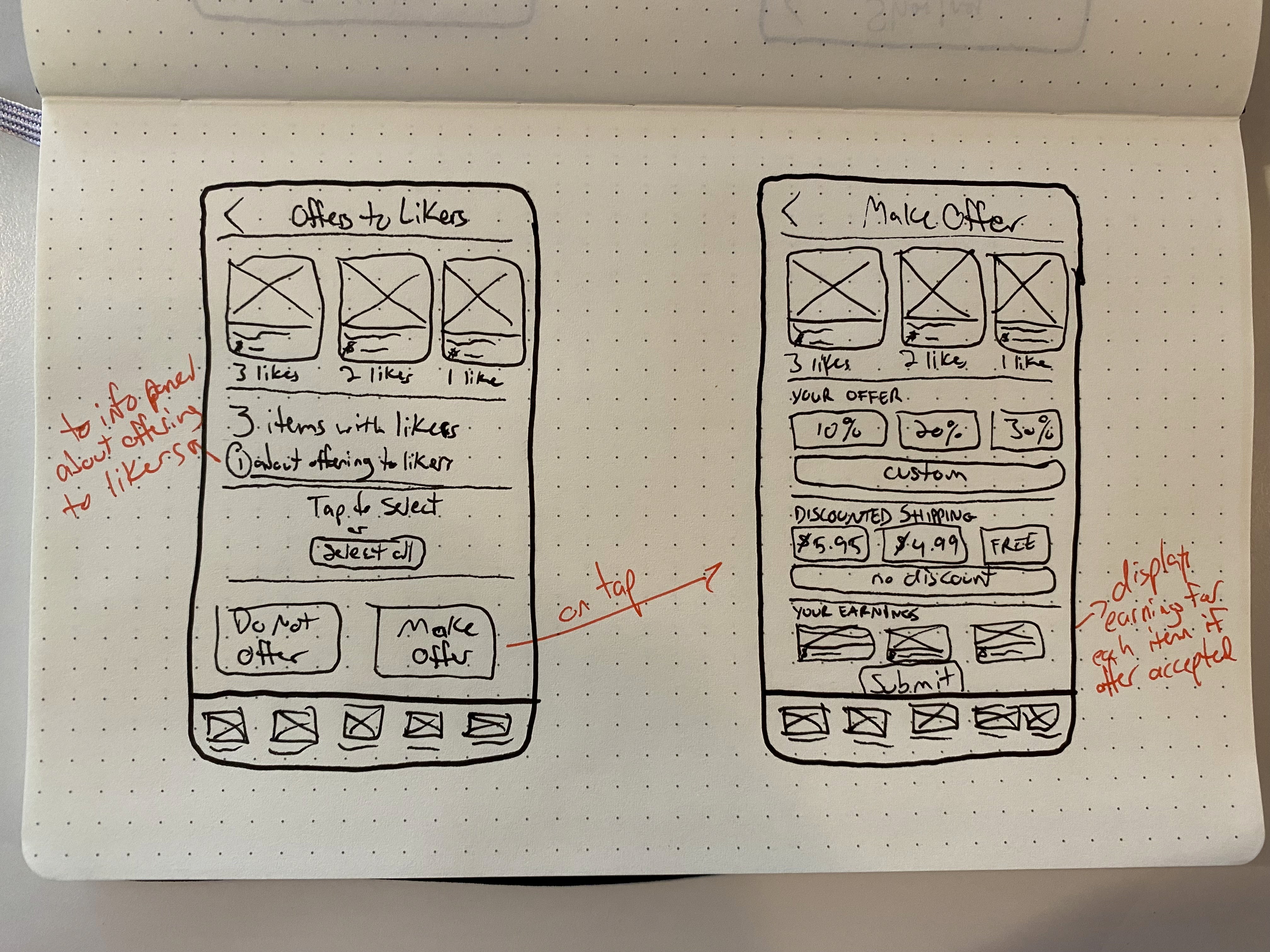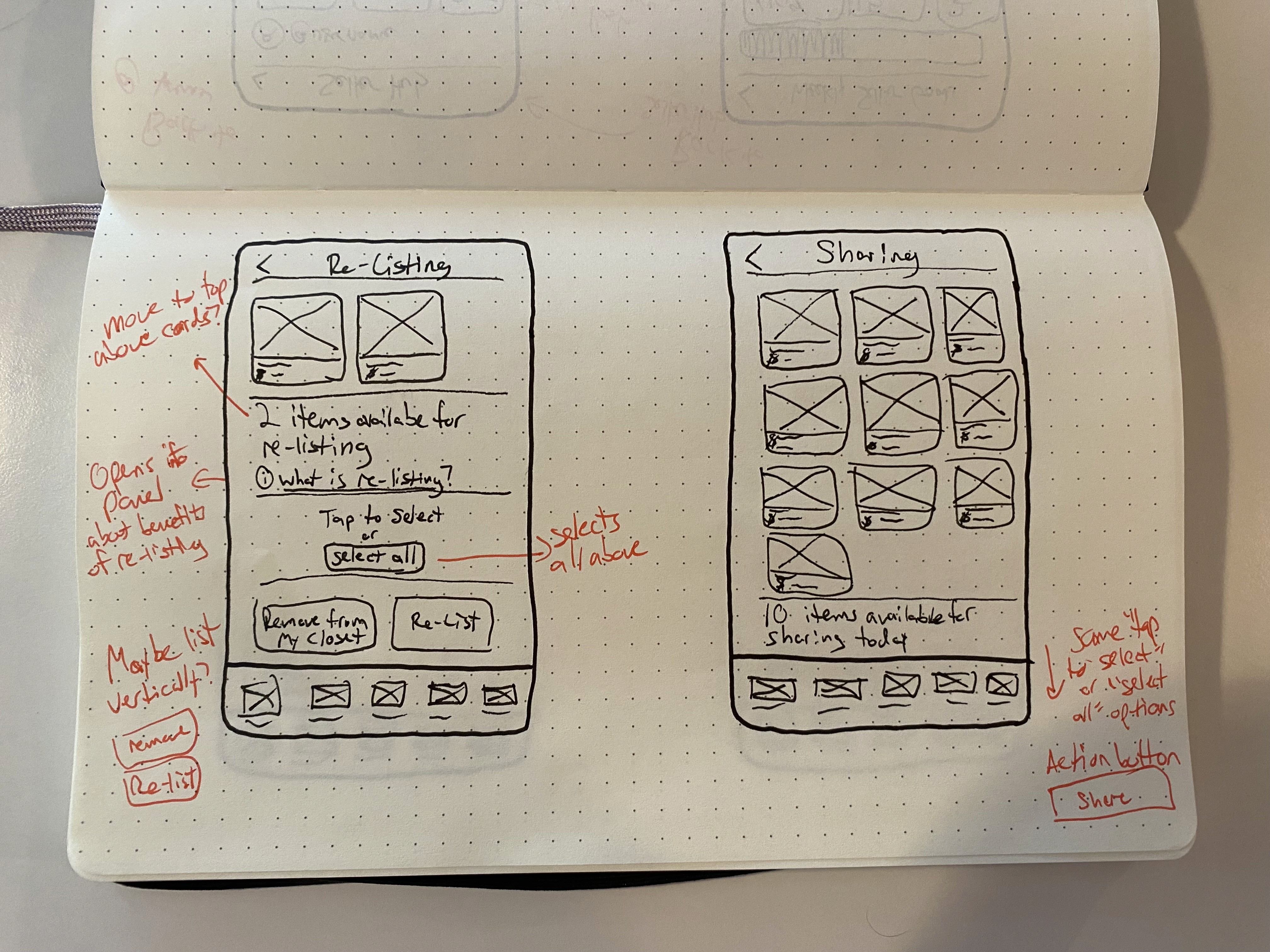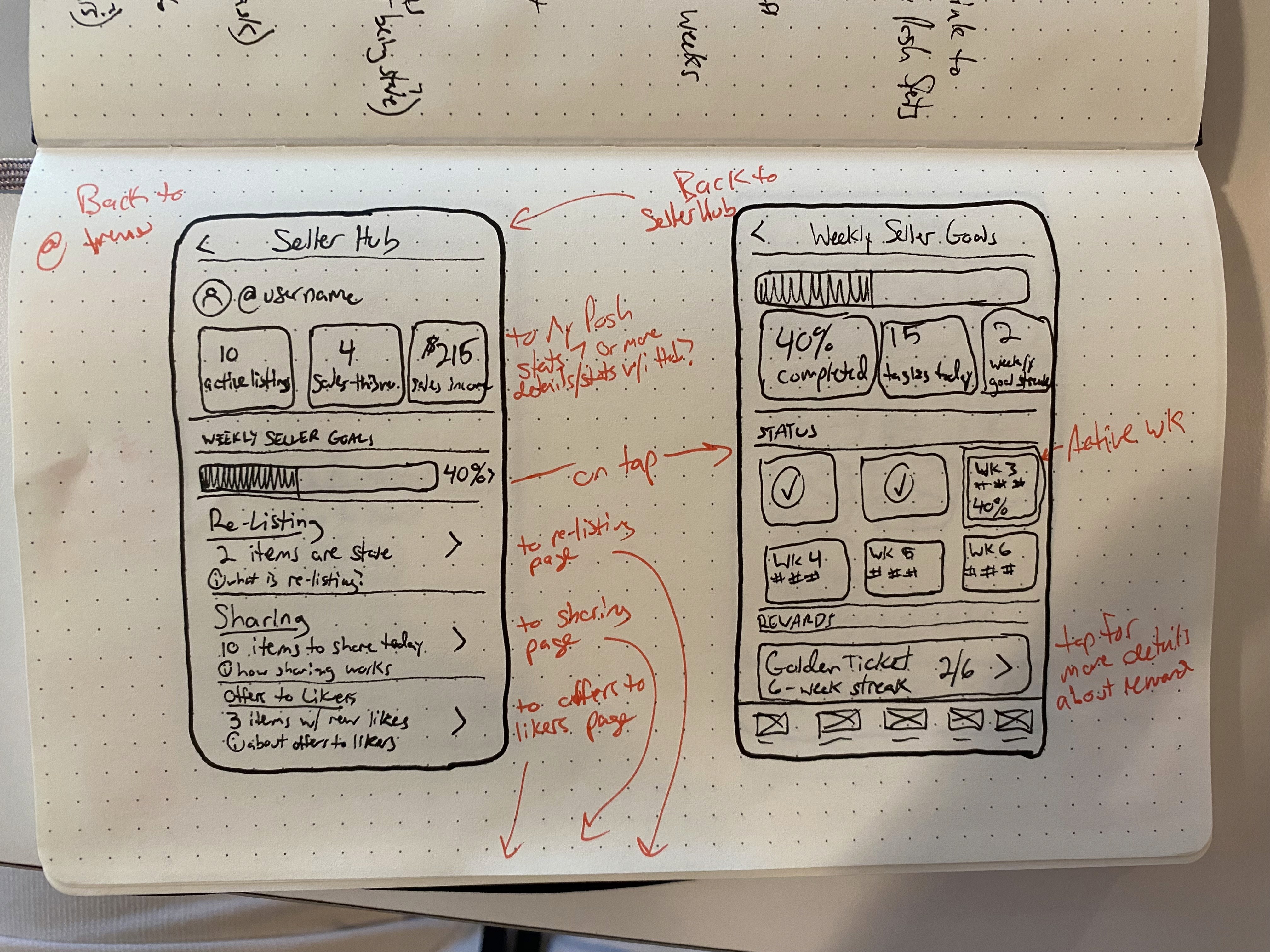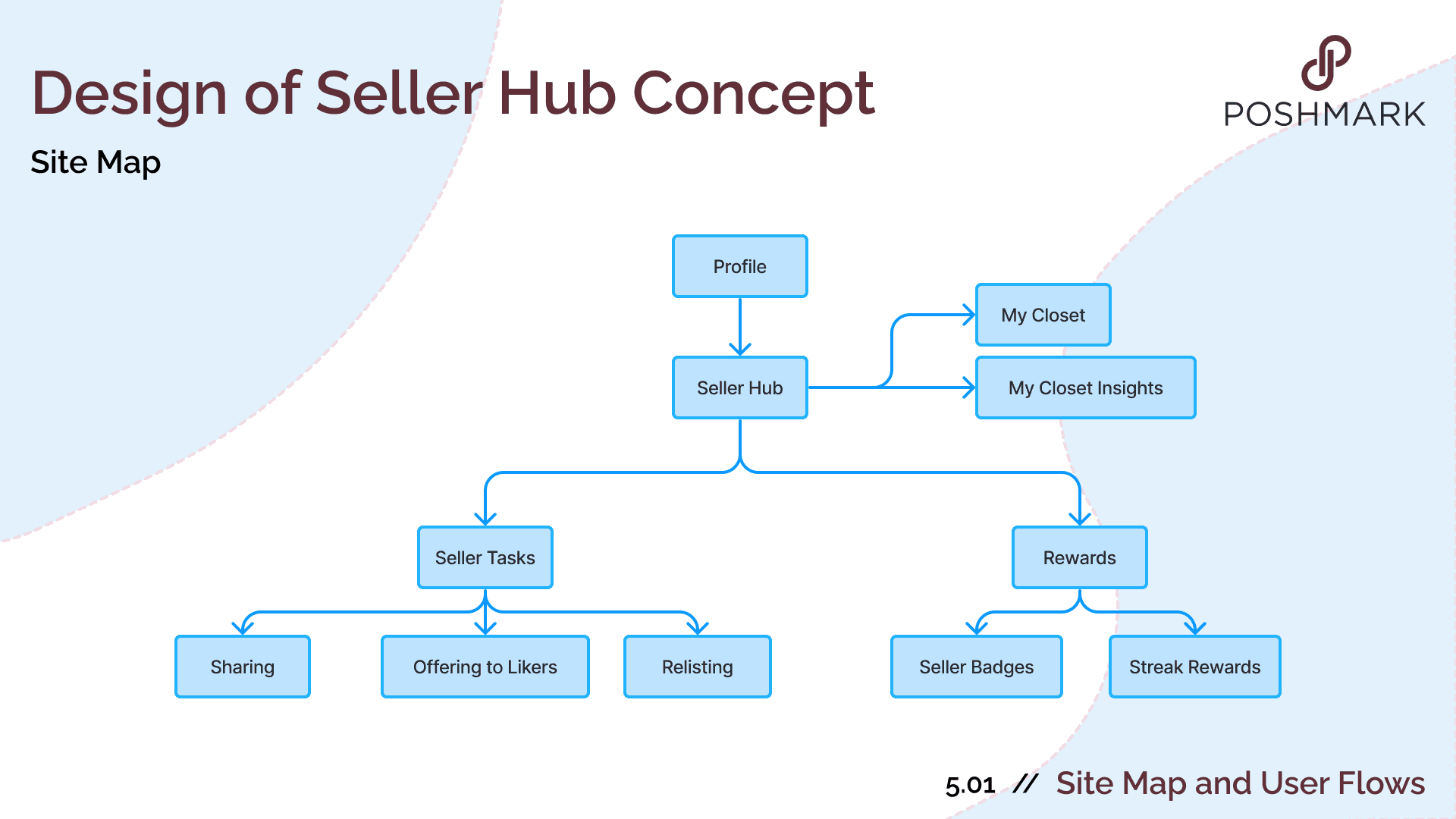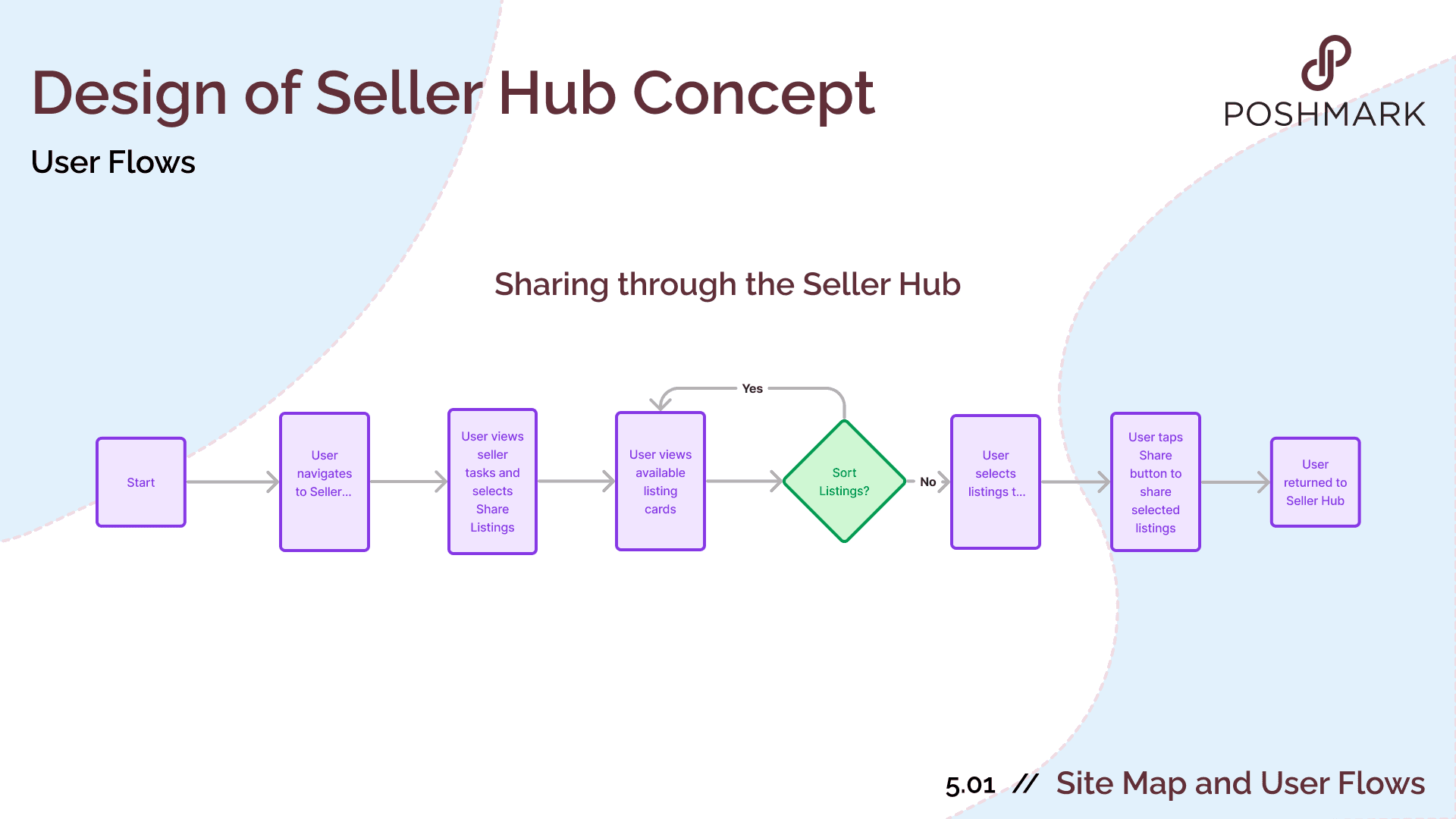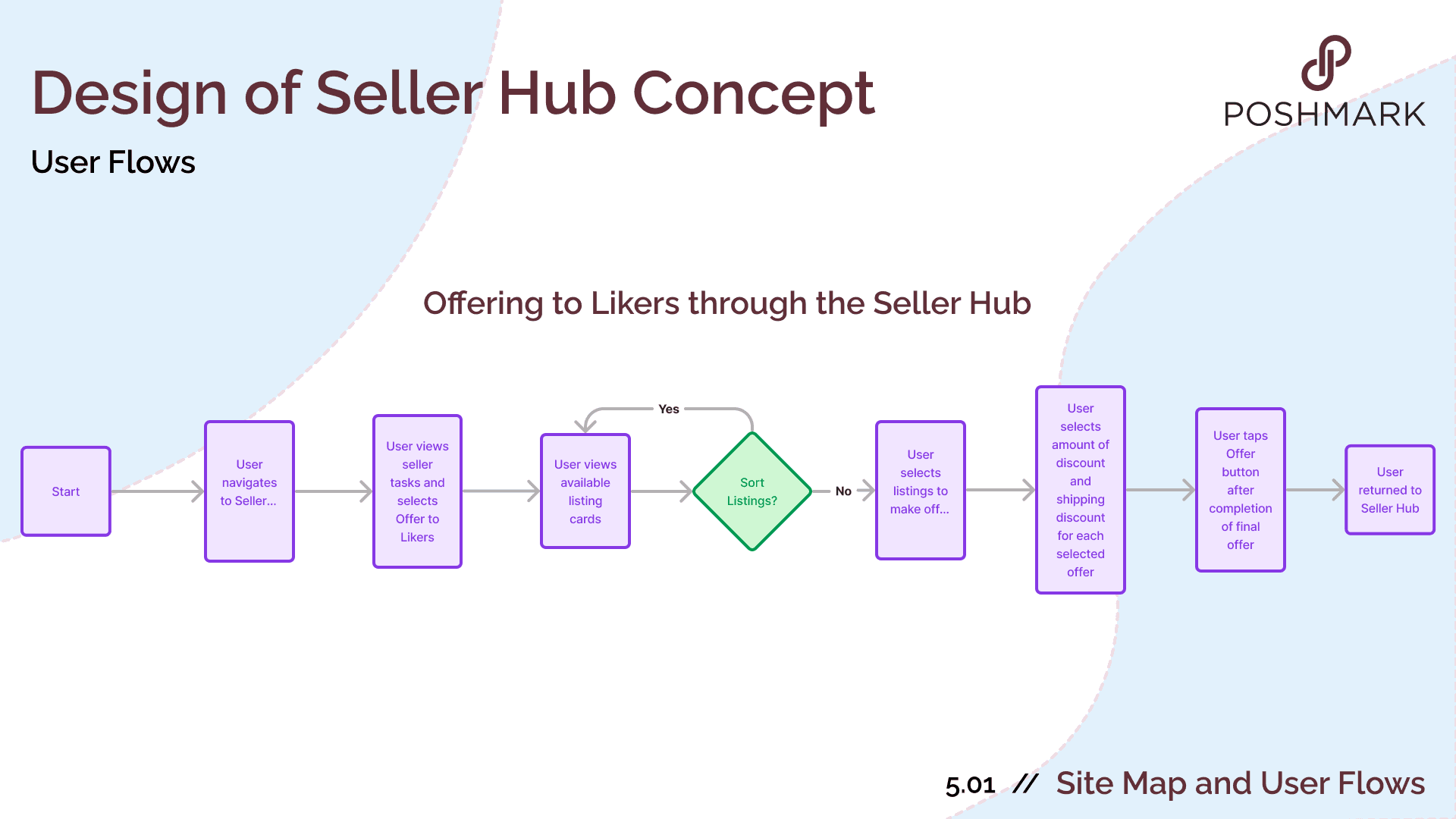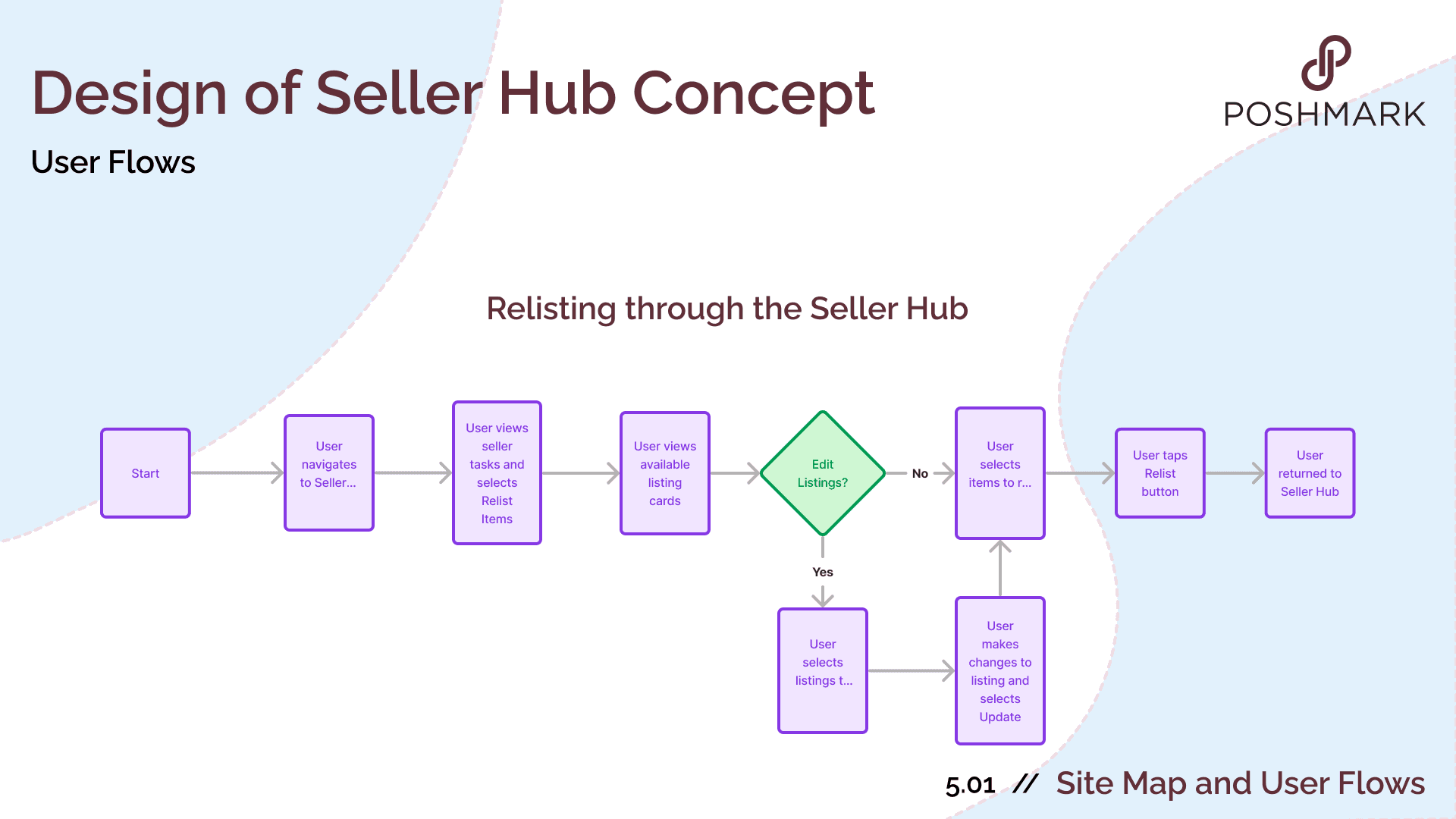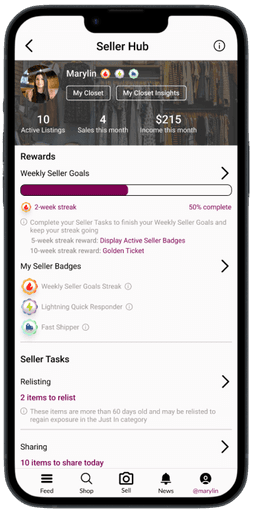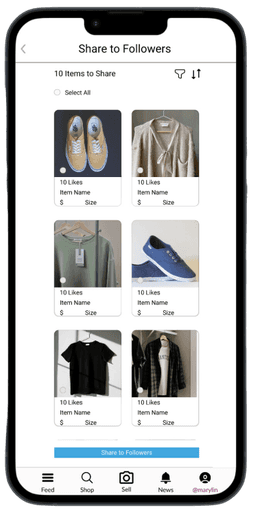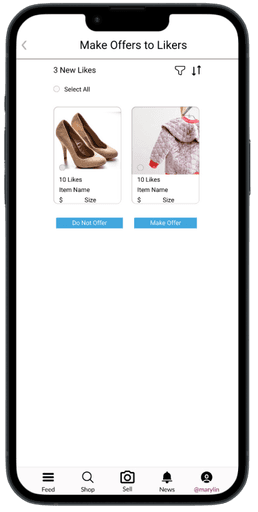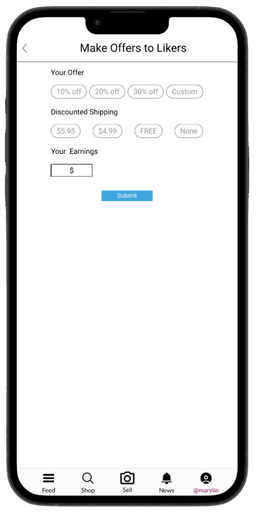
Mobile App Design
Poshmark
Team
Eric Turnbull (Project Lead)
Isaac Song (Research Lead)
Rochelle Yee (Design Lead)
Tools
Adobe Photoshop
Canva
Figma
Miro
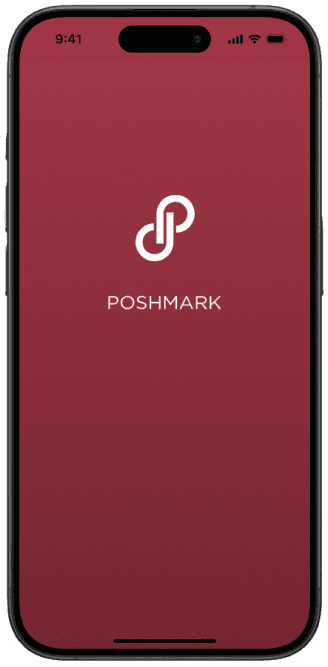
Introduction
About
Poshmark is a social marketplace where people buy and sell fashion — but what really sets it apart is the community. You don’t just list and go; you share, follow, and engage.
That social layer is powerful, but for new sellers? It can be confusing, even discouraging.
This project explores how to make that first step clearer, faster, and more motivating.
Summary
Research Lead
While I was the Research Lead on this project, I also led the overall design direction — from synthesizing insights into UX goals to building the final UI and prototypes.
I initiated and conducted foundational research to understand where casual Poshmark sellers struggle most, with a focus on first-sale drop-off and onboarding friction. From those insights, I defined the problem space, crafted experience hypotheses, and designed scalable UX solutions aligned with user needs and Poshmark’s business goals.
This case study reflects full-cycle ownership — from discovery to delivery — and mirrors how Poshmark approaches cross-functional, iterative product development.
Lesson
Reflect
Sourcing ideal participants for user testing proved challenging. Social media attracted non-target users, highlighting the need for thorough vetting. Valuable insights come from a smaller group of ideal users, not a larger one with limited experience.
While further testing will strengthen the Seller Hub, its foundation built on empathy for casual sellers provides a strong base. We're excited to iterate on task flows and rewards, ultimately empowering casual sellers on Poshmark.
Summary
Conclusion
The Seller Hub tackles a key challenge for casual Poshmark sellers: navigating the platform with confidence. Clear listing explanations, a success roadmap, and goal setting empower users, fostering a positive cycle. Effortless listing reduces frustration, sales success incentivizes further listings, and "free money" fuels continued engagement. Despite Poshmark's complexity, our user-centered approach resulted in a solution prioritizing a positive user experience.
Conclusion
Next Steps
We conducted research and comparative analysis based on features that the main competitors had.
The Seller Hub should be tested with casual sellers to validate the design’s effectiveness prior to launch using both quantitative and qualitative measurements.
Concept Testing
Phase #1
Quantitative Measurements
Qualitative Measurements
Rewards Refinement
Phase #2
Stake Holder Approval
Reward Incentives
Qualitative Feedback
Development
Phase #3
Coordinate with Dev Team
Identify any Potential Issues
Annotated Specifications Doc
Design
Design Hypothesis
We conducted research and comparative analysis based on features that the main competitors had.
User Quotes
Key Insight #1
“I want to know what I’m doing, and know that I’m doing it right, and I’ll be more excited to learn more and try harder”
“I think it's just like understanding the nature of the beast and what they want Poshmark sellers to be doing.”
“I think the overall process of relisting took a huge part of why it was overwhelming for me.”
Design Hypothesis
Key Insight #2
If we add progress tracking and lightweight rewards to the Seller Hub — like badges, goals, or a visual tracker — we can help casual sellers feel confident, know they’re on the right path, and stay motivated to keep listing.
The goal: Reinforce effort with visible feedback and make the post-listing experience feel less like guesswork — and more like progress.
Design
Ideation & Sketching
We kicked off with rapid “Yes, and…” and “How Might We” prompts to explore the problem space and spark unexpected directions.
Each teammate then sketched their own app flow.
We compared, pulled the best pieces, and aligned on a final direction.
The goal: Move fast, think wide, and build something that worked for real casual sellers — not just our assumptions.
Design
Site Map
Before diving into UI, we built a site map to simplify the entire post-listing experience.
The goal: Cut steps, reduce friction, and give sellers a clearer path through relisting, sharing, and offer tools — all inside one hub.
It became the blueprint for everything that followed.
Design
Mid-Fidelity Wireframe
These wireframes shaped the core structure of the Seller Hub — including “Share to Followers” and “Make Offer” features.
They helped test layout, reduce friction in user flows, and validate whether casual sellers would understand what to do next.
The goal: Build a skeleton that solved confusion before polishing pixels.
Research
Problem Statement
Casual Poshmark sellers need a faster, simpler way to stay active — without getting lost in the mess of relisting, sharing, and sending offers.
Right now, the process feels confusing, repetitive, and too much for anyone not trying to sell full-time.
Ideation
Design Goals
With clearer user problems in focus, we defined three key goals to make post-listing activity easier, faster, and more motivating — especially for casual sellers.
Centralize Post-Listing Activity
Key Insight #1
Create a Seller Hub that gives casual sellers structure and visibility — a single place to handle everything after they post.
Gamification
Key Insight #3
Use simple gamification (badges, streaks, feedback) to help sellers see their progress and feel motivated to keep going.
Streamline the work
Key Insight #2
Make core actions like relisting, sharing, and sending offers faster — fewer taps, fewer screens, less confusion.
Everything flows through the Seller Hub.
Research
User Interview
We conducted research and comparative analysis based on features that the main competitors had.
We talked to 5 casual sellers, ages 25–40, to understand what’s actually stopping them from staying active on platforms like Poshmark.
Motivation
Key Insight #1
Most casual sellers just want to clean out their closet and get what they called “free money.”
They’re not trying to build a brand — they just want quick, easy wins.
Confidence
Key Insight #2
Sellers didn’t know what to expect after listing — and felt stupid for not getting likes.
No plan, no feedback, no direction. Many quit before trying a second item.
Direction
Key Insight #4
Sellers felt lost.
There were no cues on what to do next — and no sense of progress.
Time
Key Insight #3
Notifications. Offers. Shares. Reminders.
Selling felt like a second job — one they didn’t sign up for.
The goal: Figure out what kills momentum — and what would help them stick around.
Research
Task Analysis
We conducted research and comparative analysis based on features that the main competitors had.
What’s slowing casual sellers down — and why they’re giving up.
Relisting Items
Key Insight #1
Relisting is buried in “Edit Listing” and takes 6+ taps.
This means items go stale and sellers lose motivation fast.
It’s manual, repetitive, and easy to miss.
Most casual sellers don’t even know it’s an option.
Sharing Items
Key Insight #2
Sharing listings one by one is exhausting.
A core feature becomes invisible creating unnecessary friction daily.
Bulk Share exists, but it’s hidden behind filters and settings.
Most casual sellers don’t discover it.
Offers to Likers
Key Insight #3
Creating offers requires 10+ steps per item.
Time cost kills intent. It feels like work - not selling.
Sellers have to fill out forms they don’t understand.
Most give up before they finish.
Evaluating and analyzing the tasks a Poshmark user must perform to maintain listing visibility and complete a sale illuminates several key areas of frustration for users.
Design
High Fidelity Prototype
We conducted research and comparative analysis based on features that the main competitors had.
We built a Seller Hub that gives casual sellers structure, motivation, and a clear path to post-listing success.
Seller Task & Rewards
Seller Hub
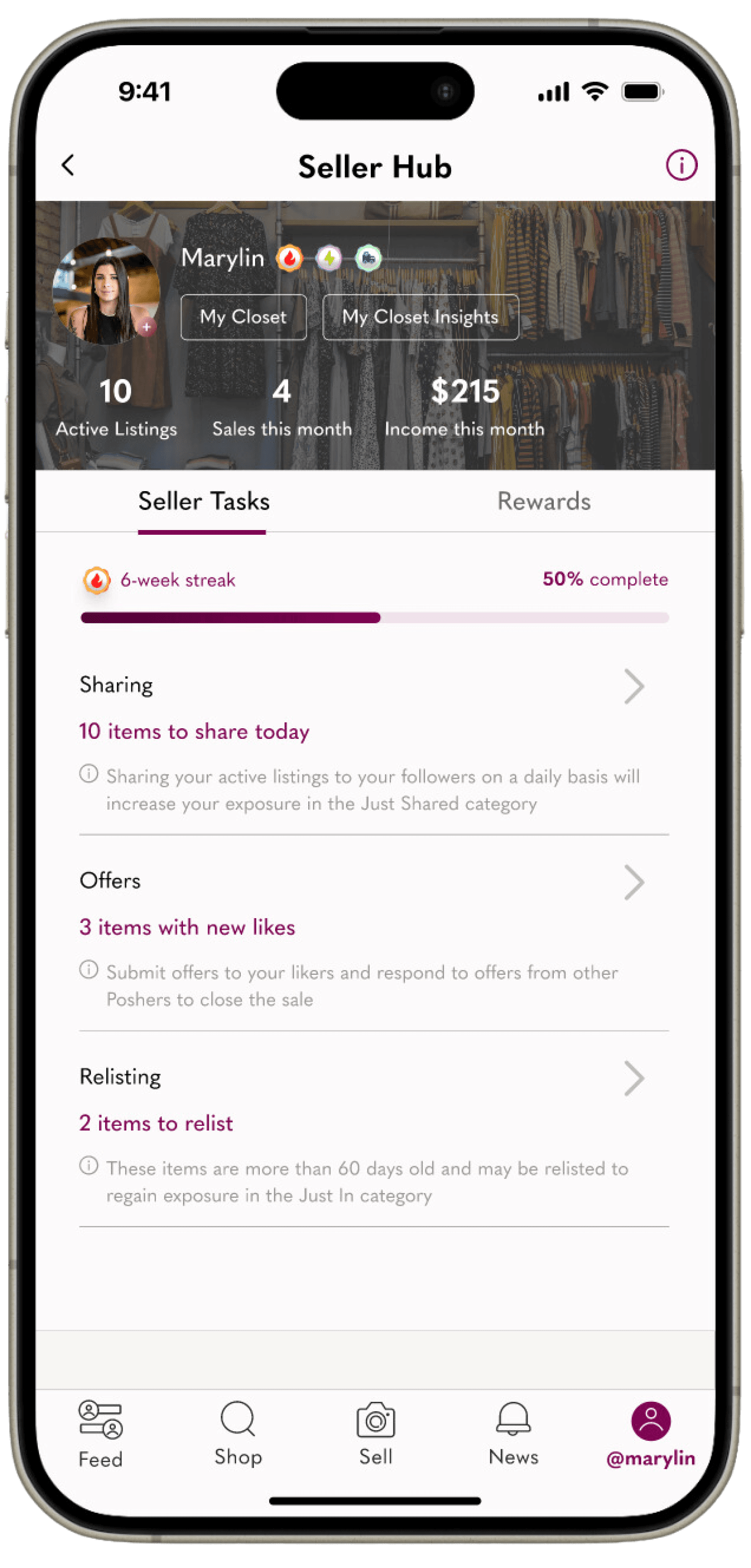
Seller Task - Info Toggle On
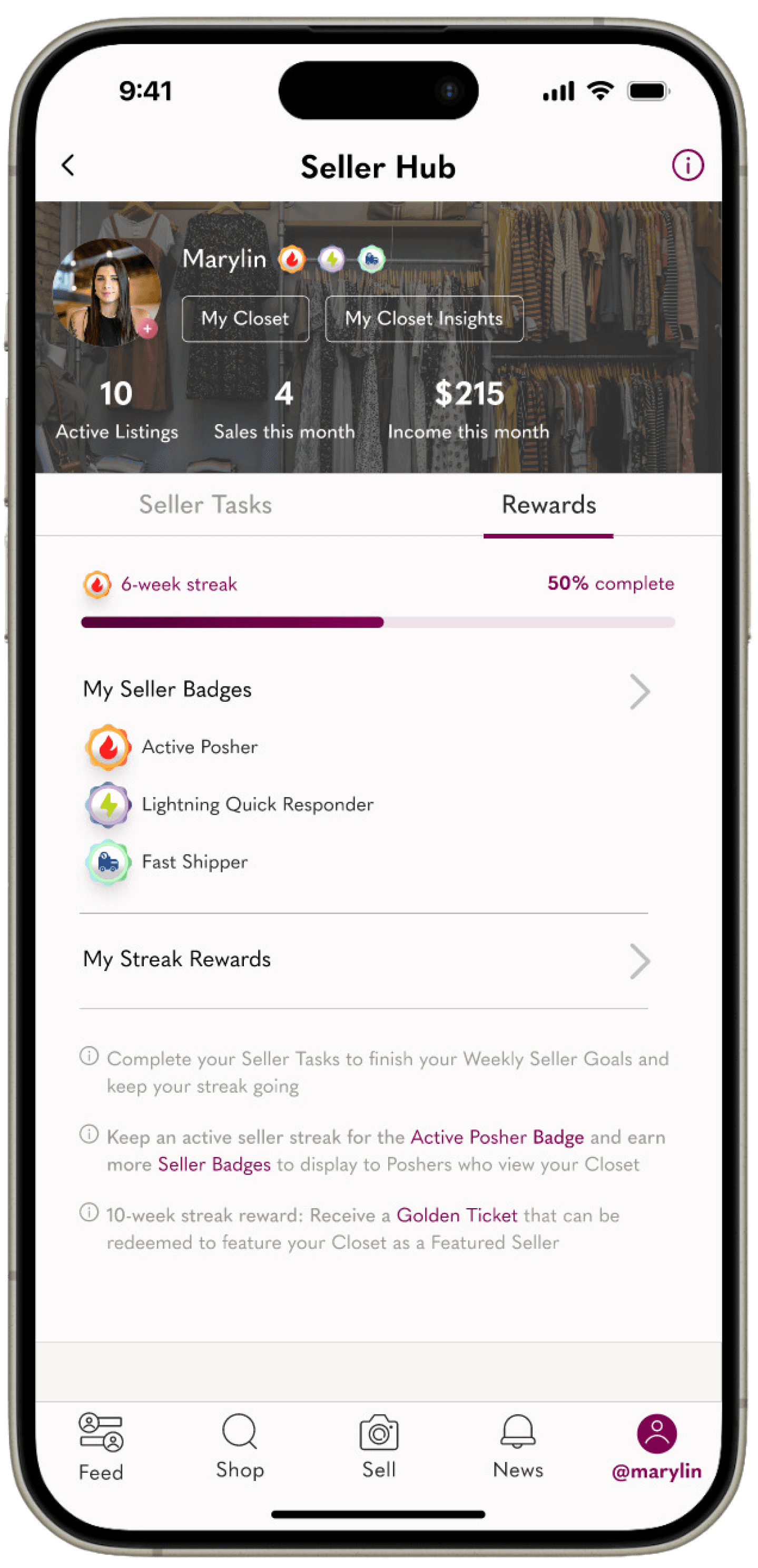
Rewards - Info Toggle On
Shows sellers what to do next (share, offer, relist)
Uses progress bars to make the process feel like winning
Explains why each task matters (not just what to do)
Seller Task
Helps sellers track weekly streaks + unlock goals
Displays earned badges to build credibility
Encourages habit-building without pressure
Rewards Tab
Bulk Sharing with 3 Taps
Share to Followers
Share to Followers
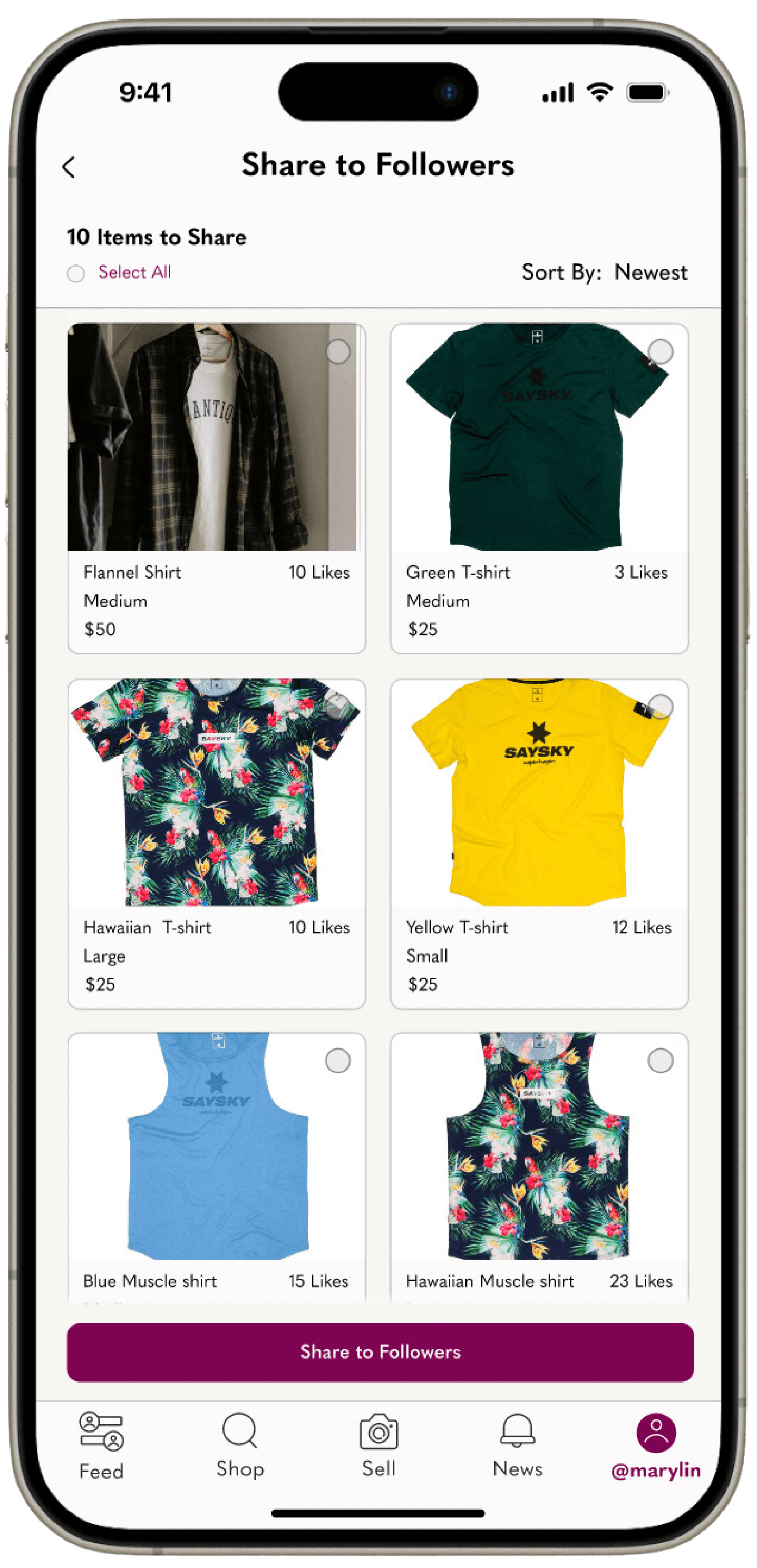
Everything visible at once
Sellers see all active listings immediately.
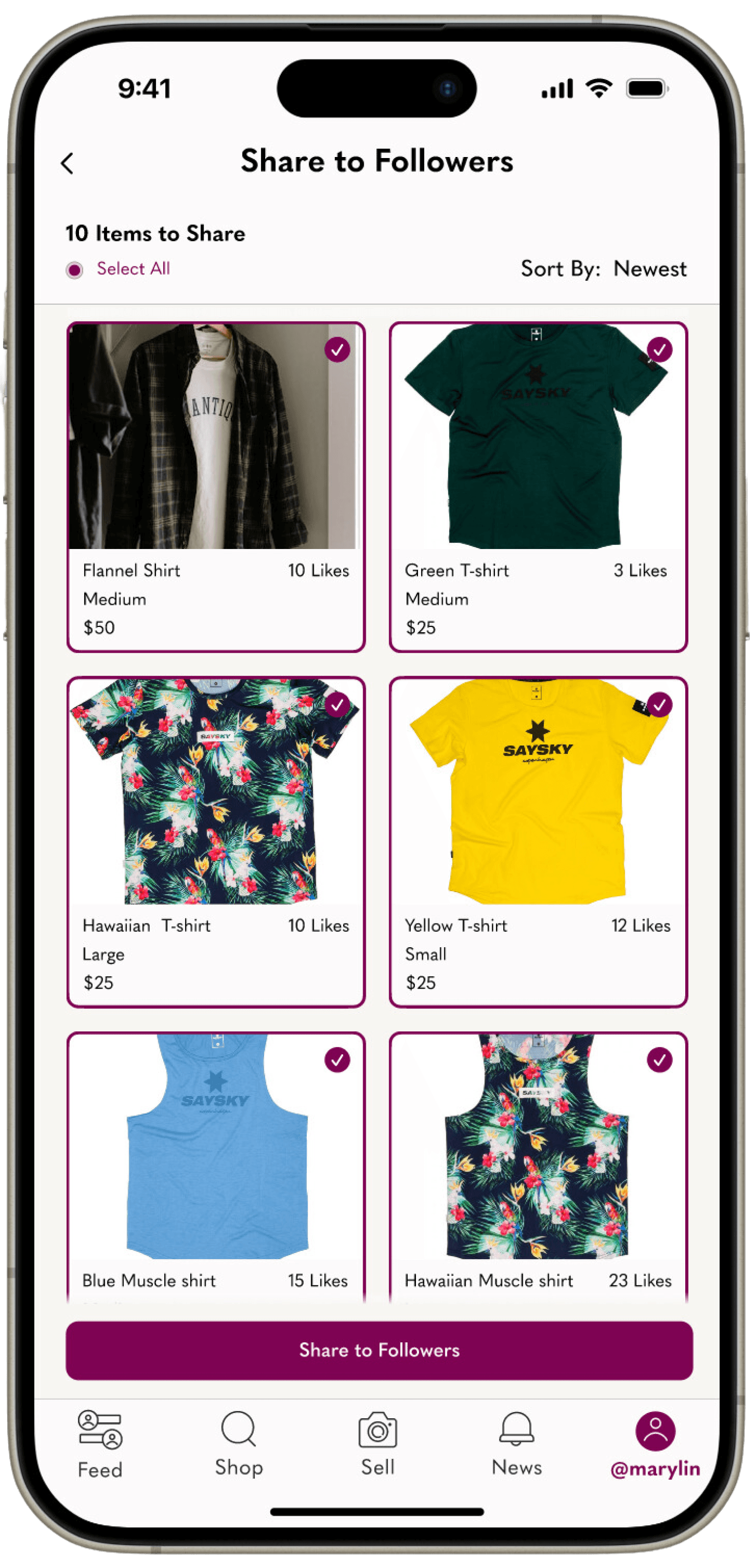
Share to Followers - Select All
Tap to select all
No more hunting for bulk sharing tools.
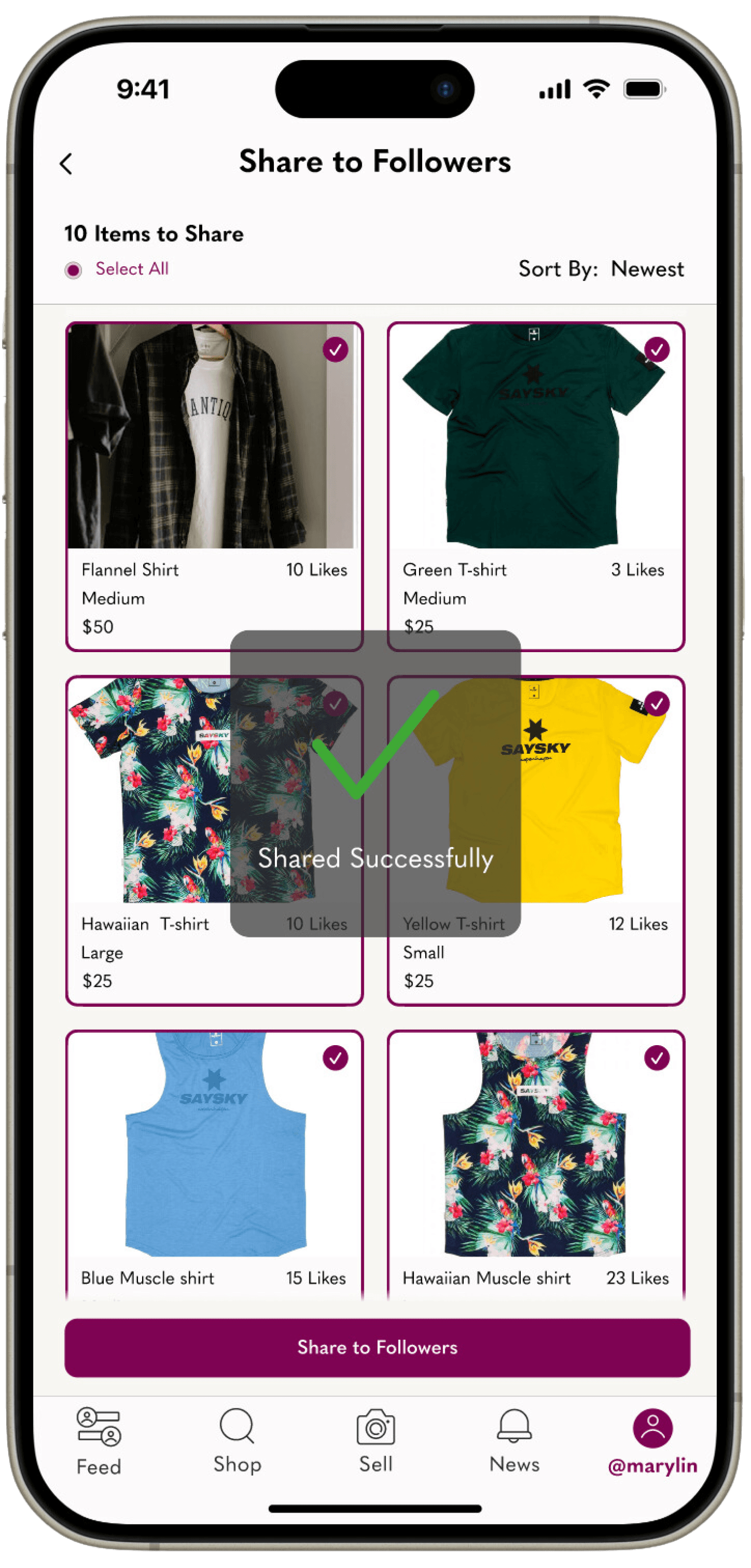
Share to Followers - Share Button
Tap to share
Confirmed, shared, done.
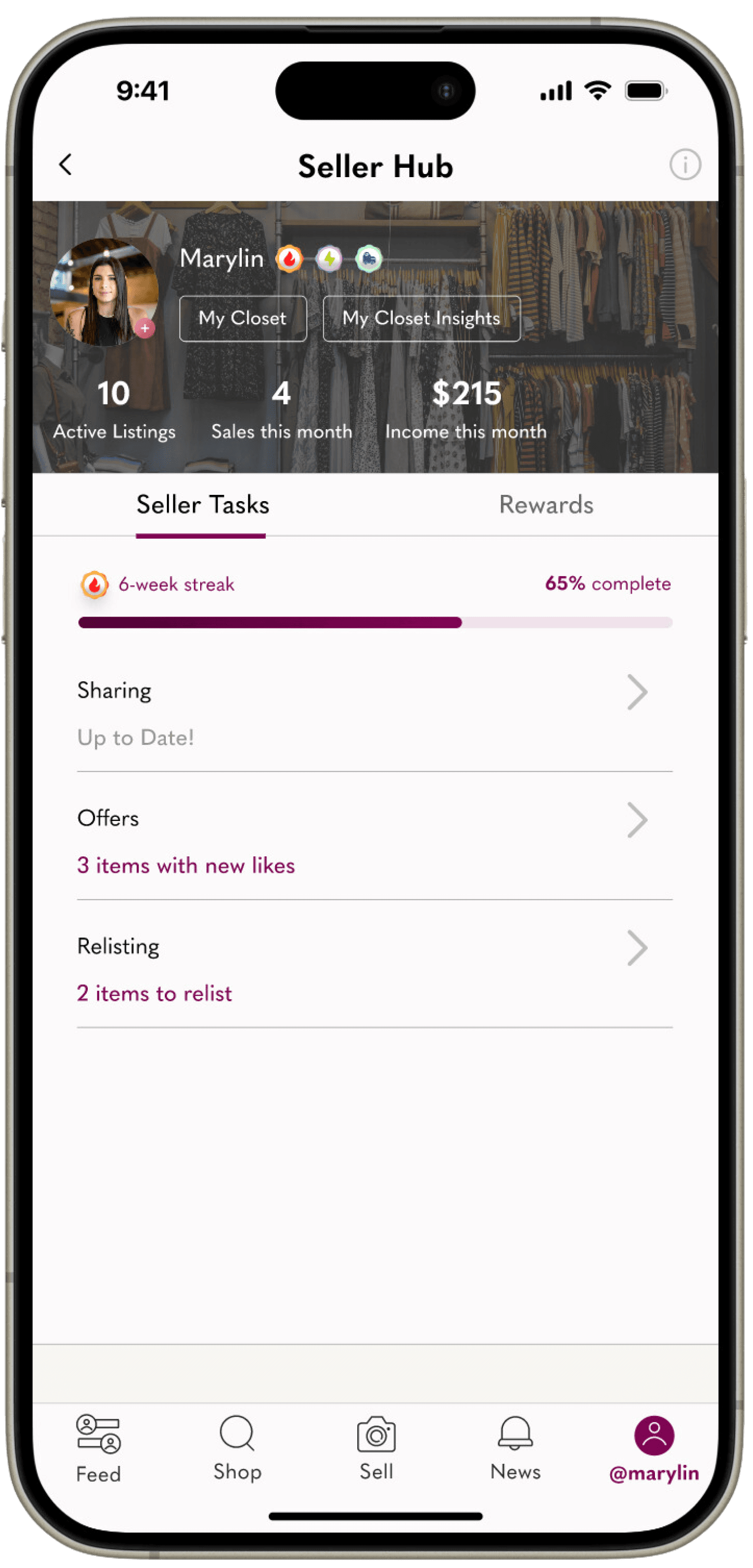
Seller Hub - Seller Task
Progress tracked
Seller Hub updates automatically so users know they’re on track.
Sharing listings used to feel buried and repetitive.
Now? One tap to select all, one tap to share, and it’s done.
Offering to Likers in a Single Streamlined Process
Offers to Likers
Offers to Likers - Select All
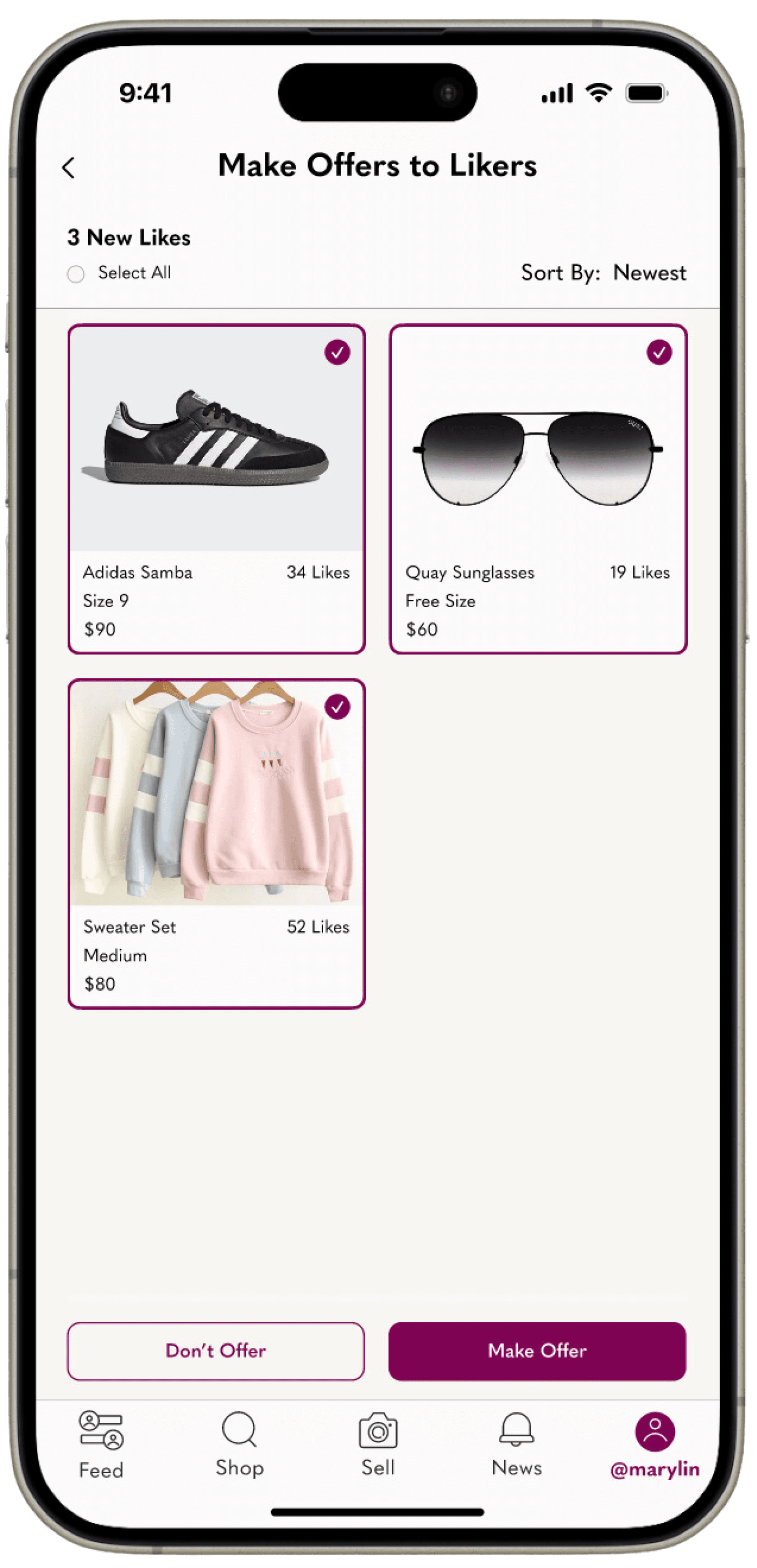
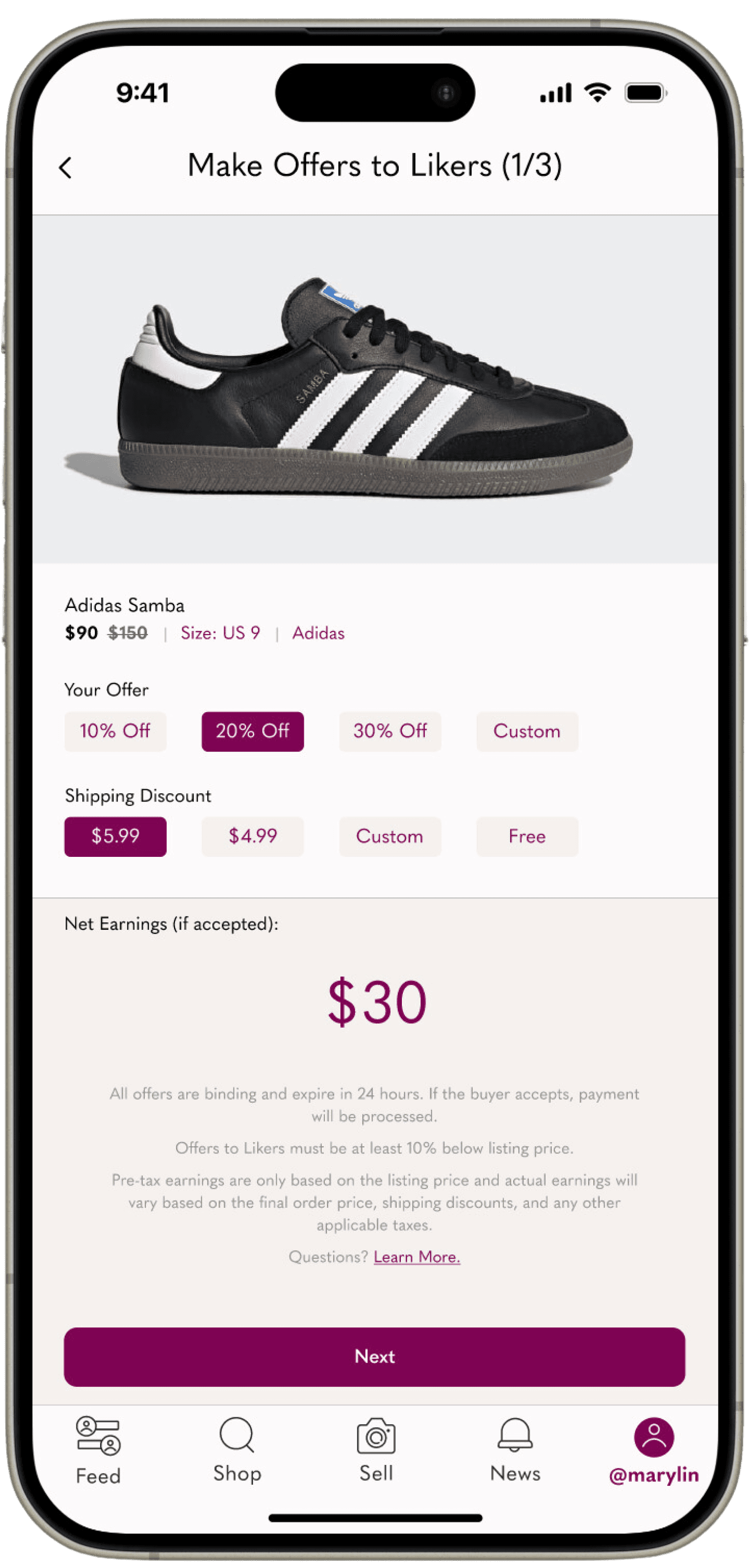
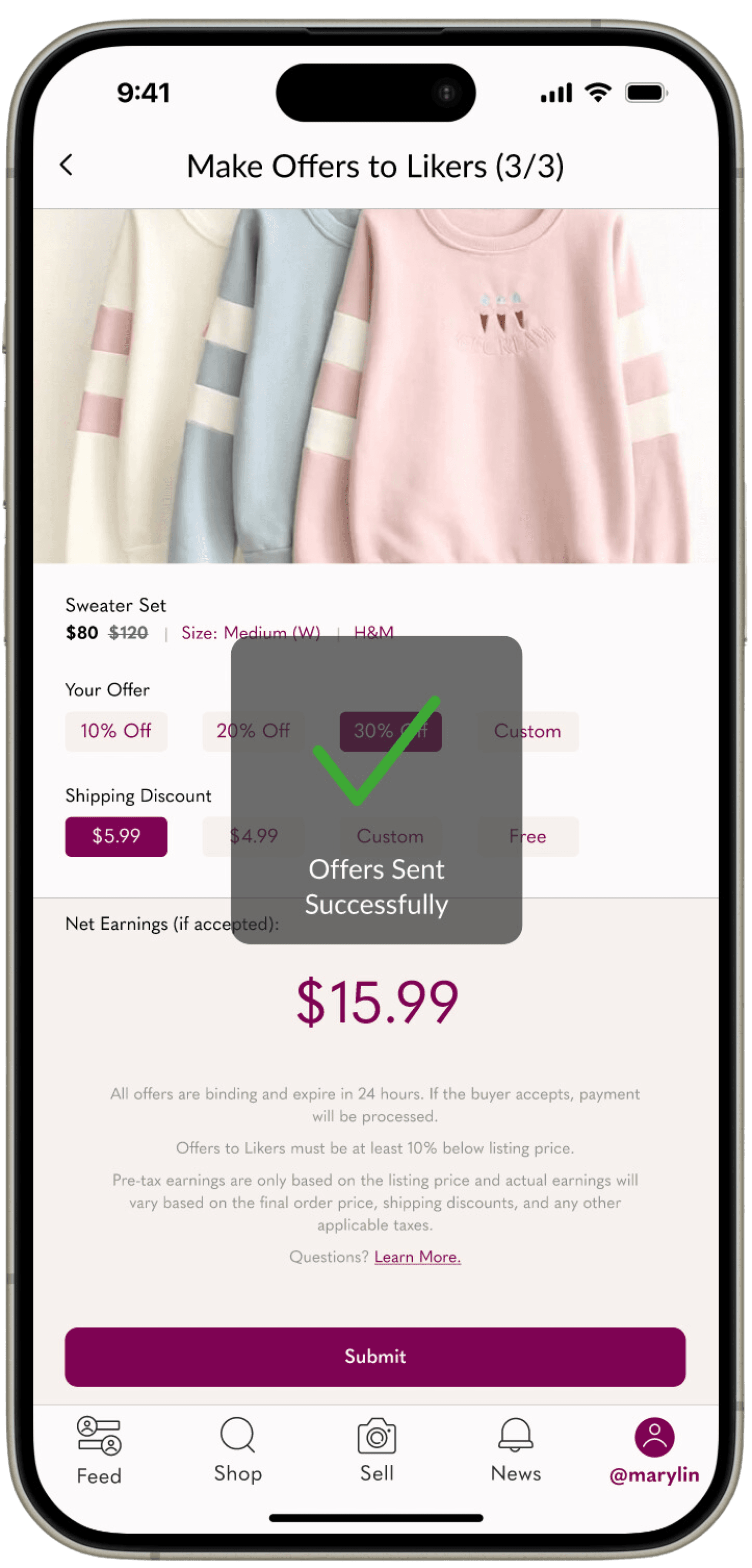
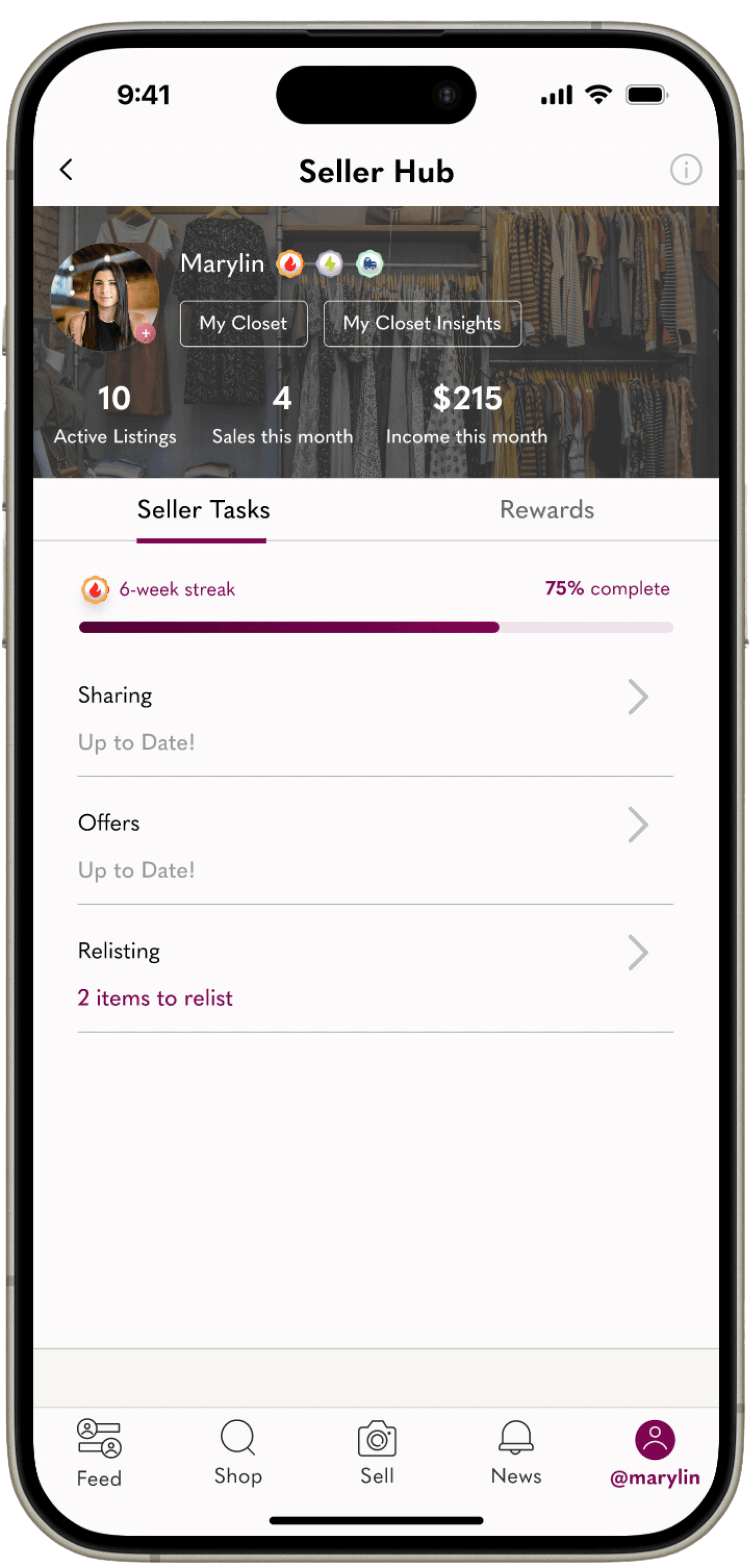
Offers to Likers - Individual Page Review
Offers to Likers - Offer Sent
Seller Hub - Seller Task
Consolidated process for making
offers to likers in one task
Individual pages to review and make each offer
User returned to Seller Hub, where offers are up to date and progress bar is updated
Relisting Stale Items with Ease
Relist Items
Offers to Likers - Select All
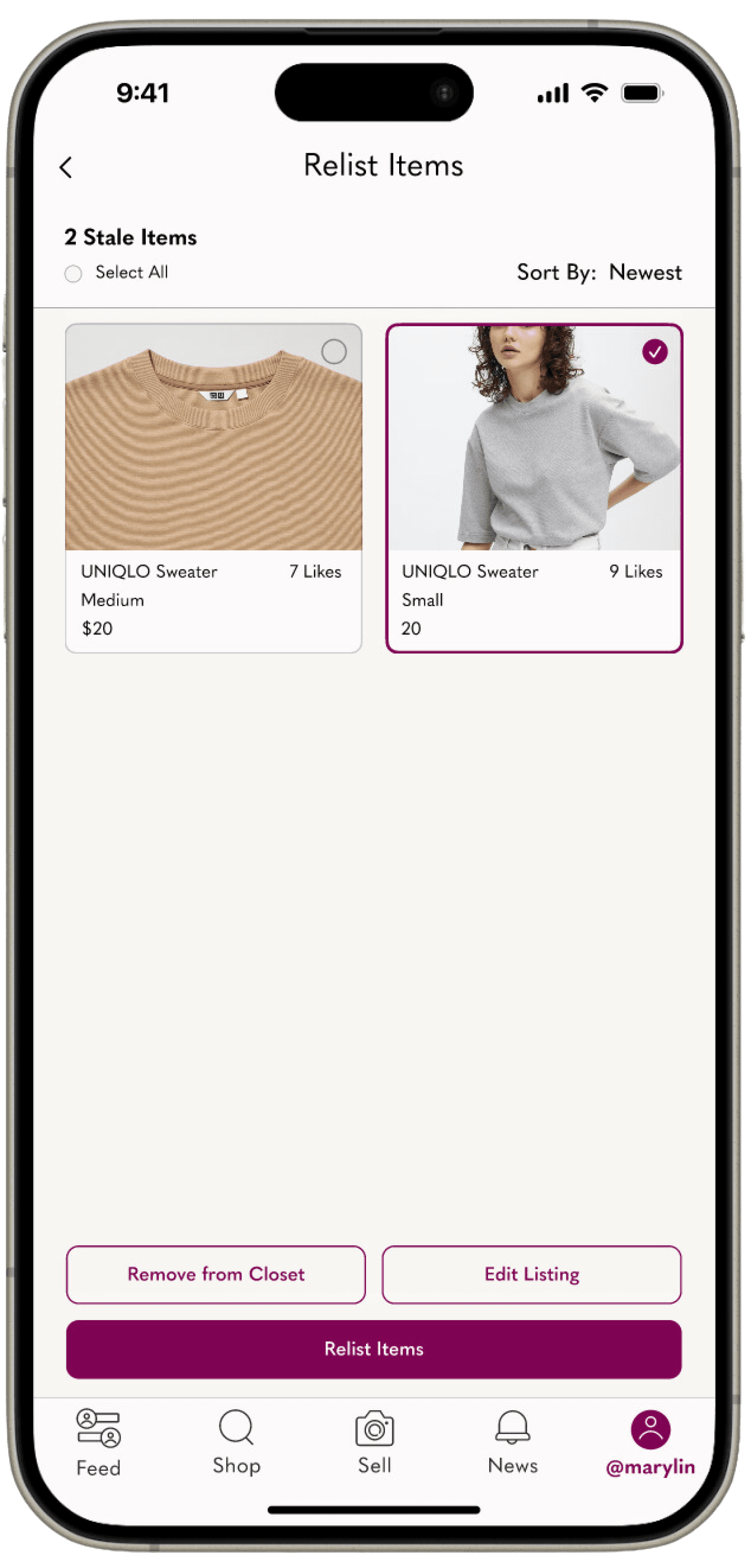
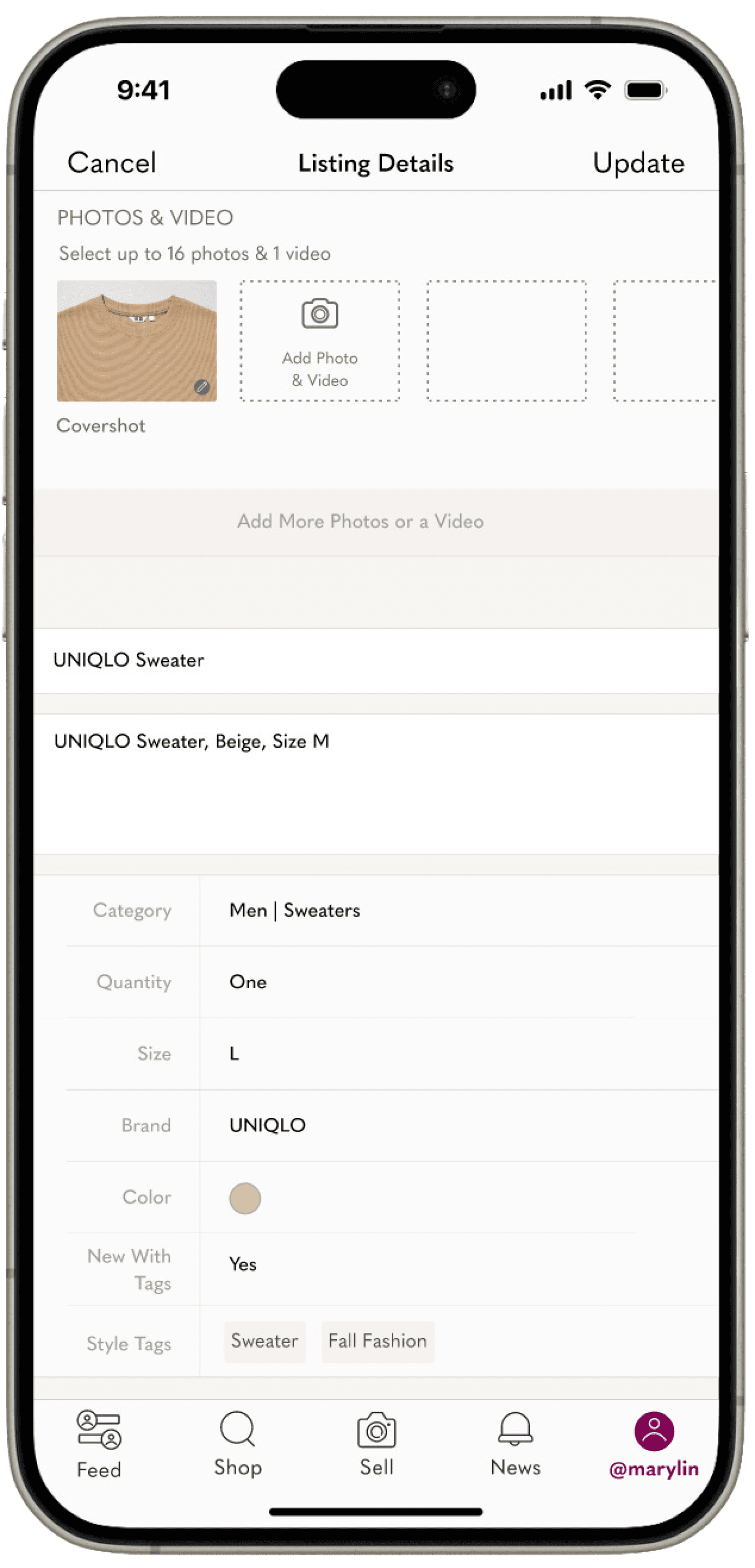
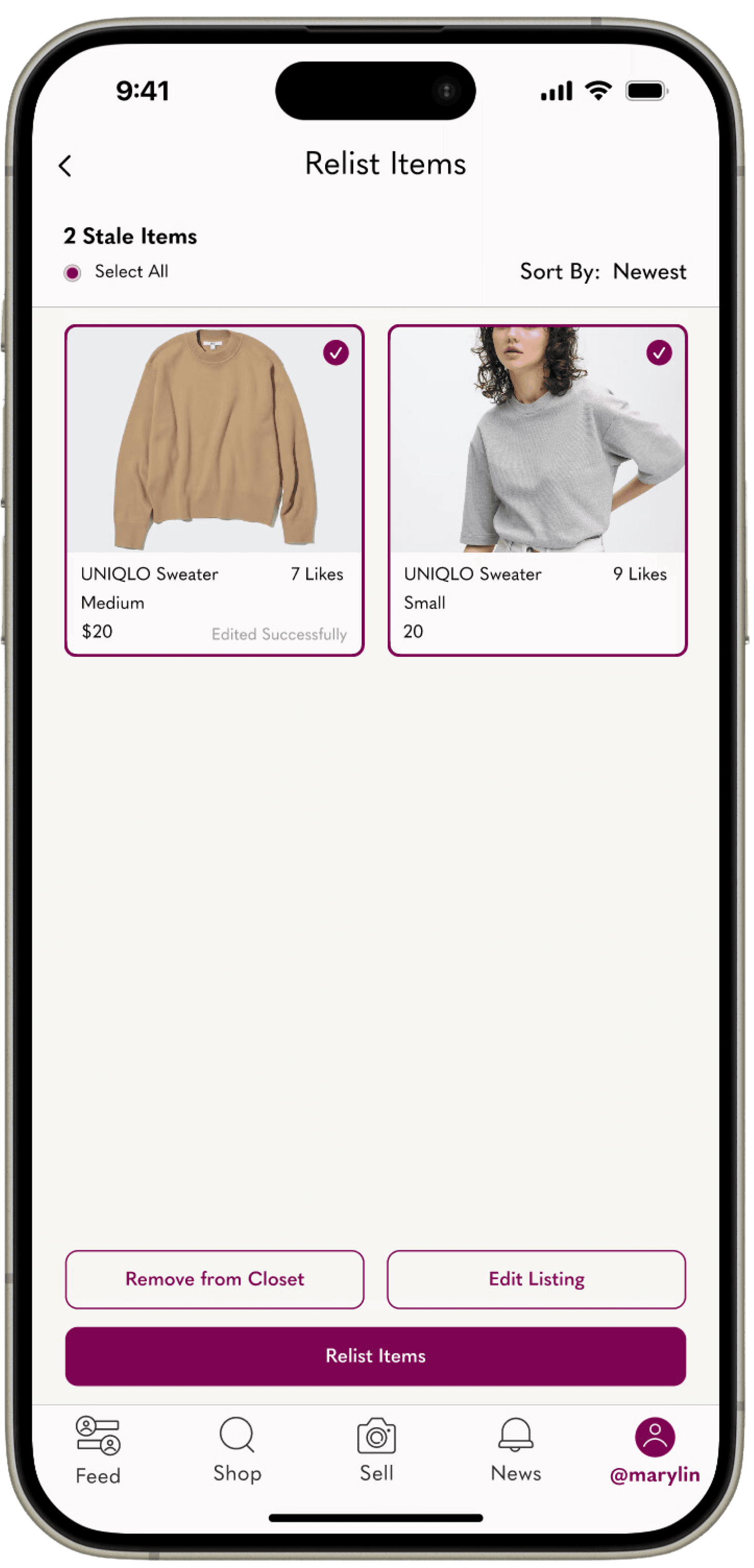
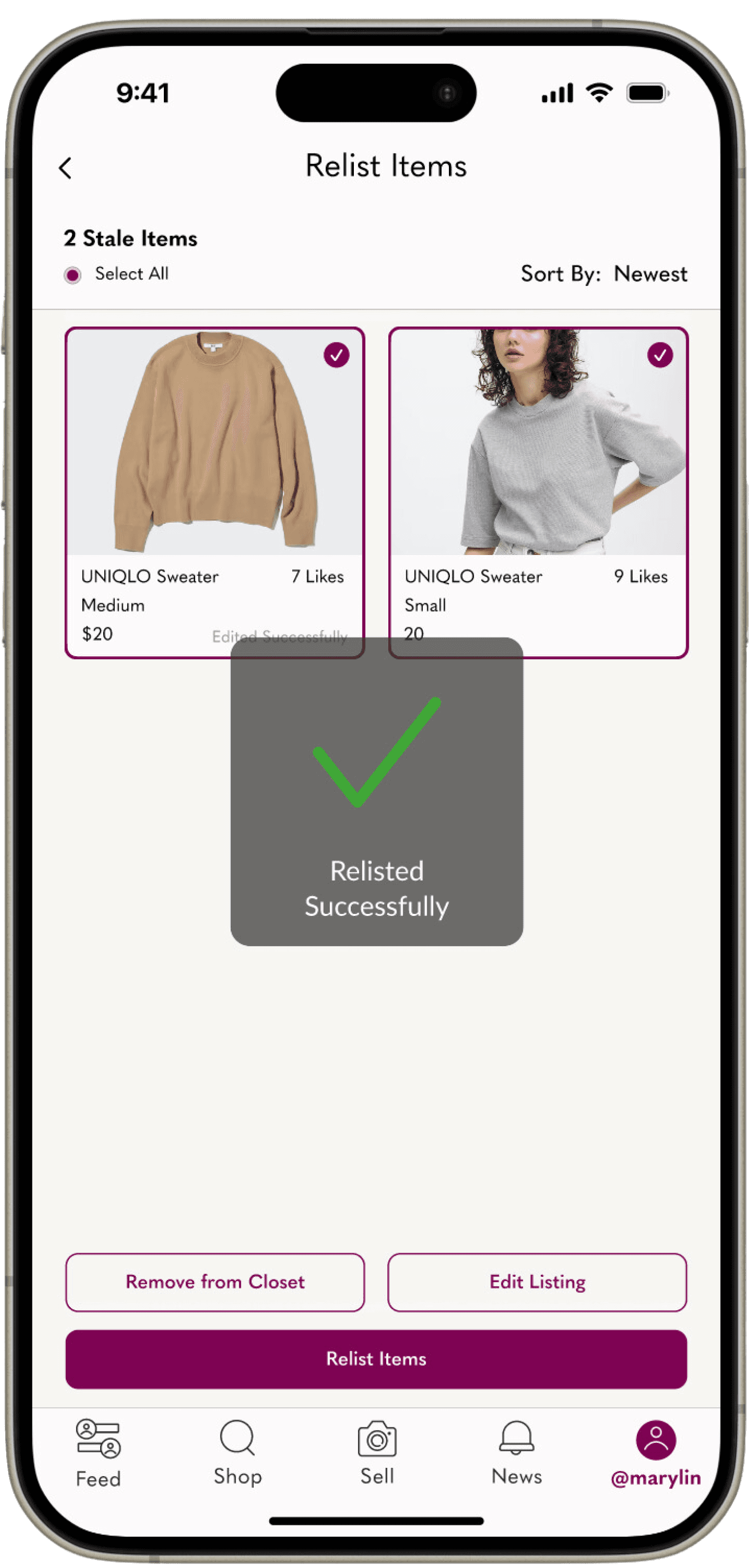
Offers to Likers - Individual Page Review
Offers to Likers - Offer Sent
Seller Hub - Seller Task
Consolidated process for making
offers to likers in one task
Individual pages to review and make each offer
User returned to Seller Hub, where offers are up to date and progress bar is updated
Incentivizing Follow Through with Seller Tasks
Seller Hub
Rewards - Badges
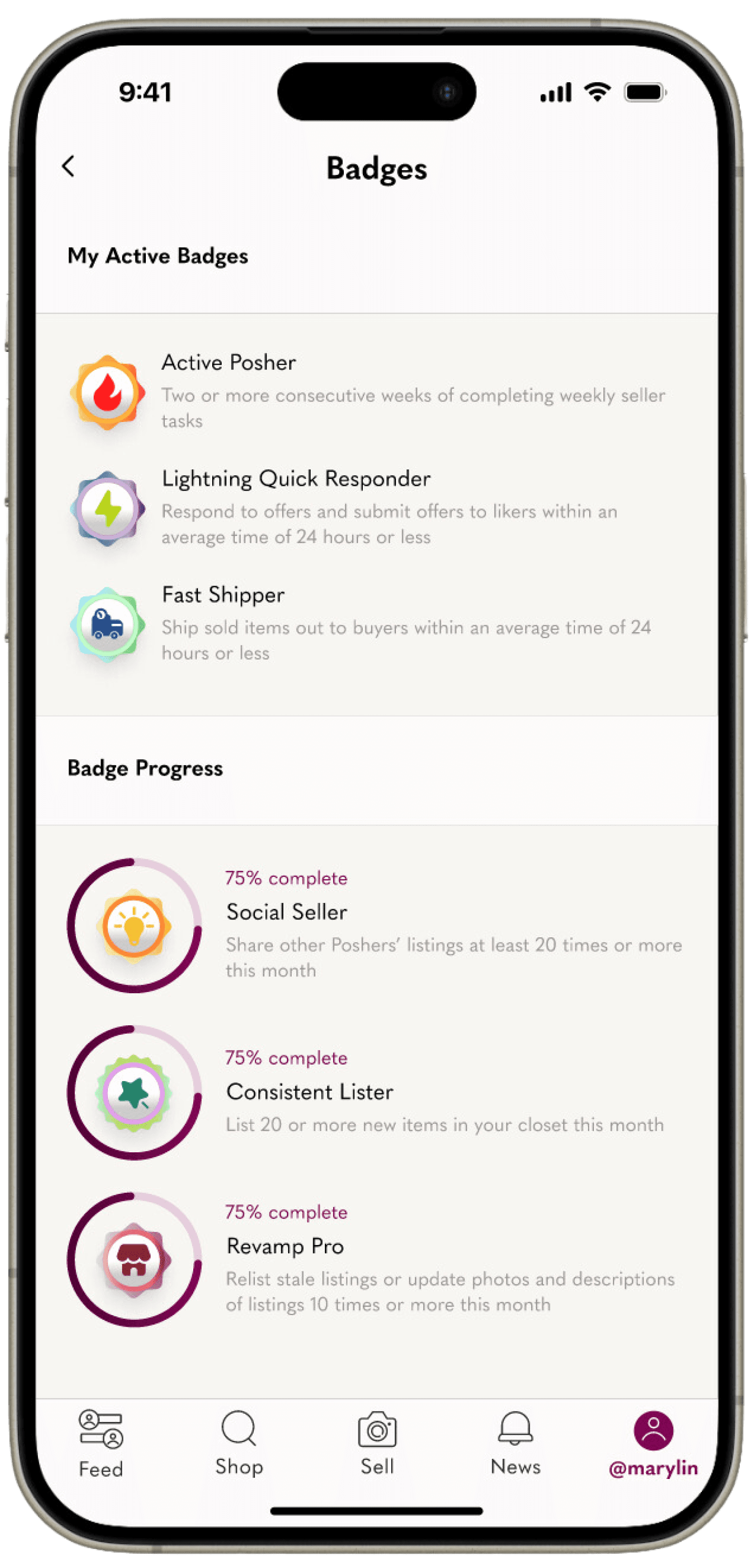
Streak Rewards
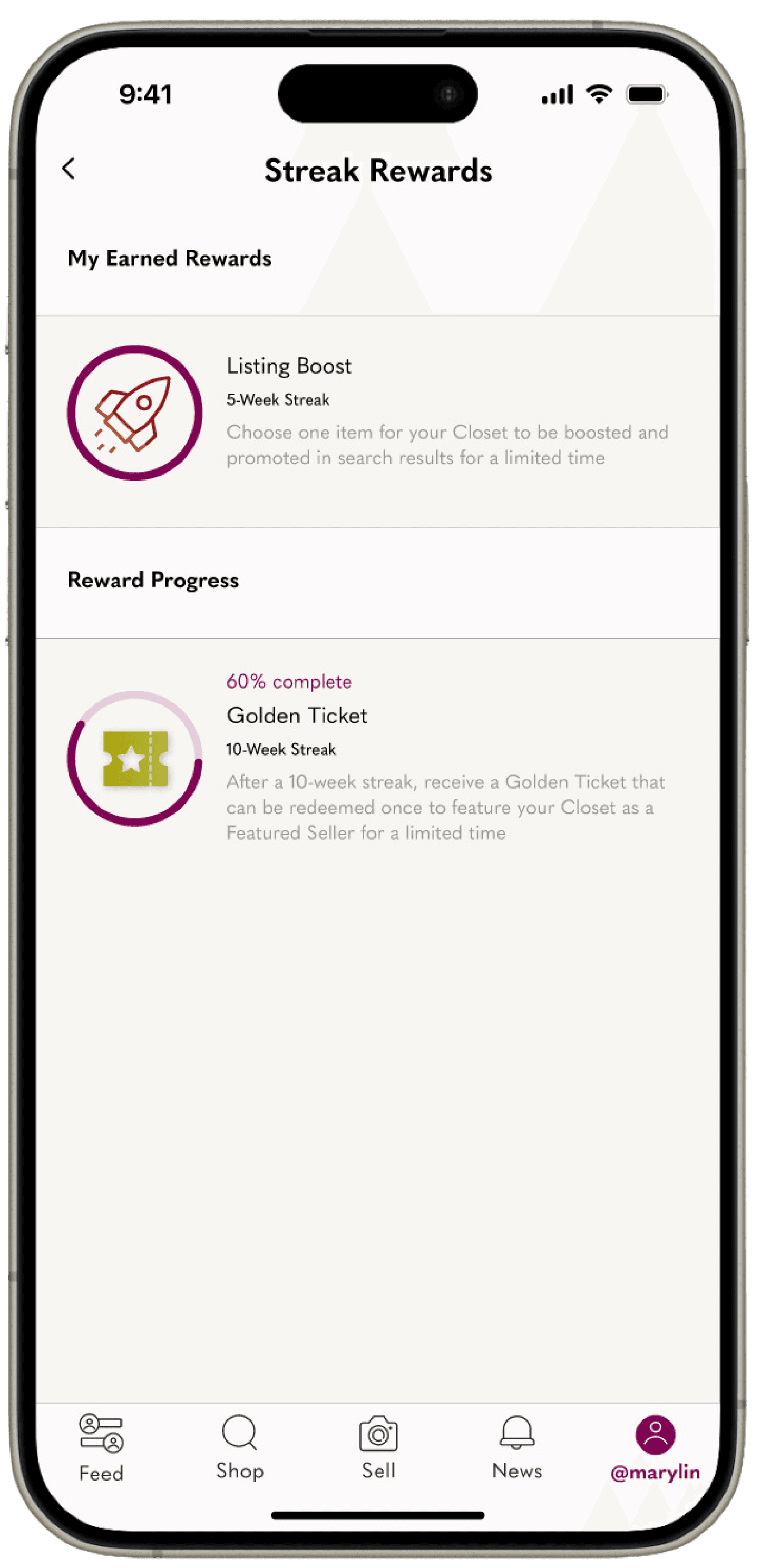
Active Posher - Maintain a weekly seller goals streak, indicating high activity to buyers
Lightning Quick Responder - Offer to likers in less than 24 hours, indicating responsiveness to buyers
Fast Shipper - Ship in less than 24 hours on average, indicating quick delivery to buyers
Social Seller - Share 20+ listings from other sellers, indicating engagement with Poshmark community
Consistent Lister - List 20+ new items, indicating fresh and updated Closet
Revamp Pro - 10+ relistings or listing updates, indicating attention to Closet
Vendor Icons Shown in
Vendor's Wardrobe
Golden Ticket - Feature yourself as a top seller for a limited time.
Previously reserved for Poshmark ambassadors now unlocked by effort.
Listing Boost - Choose one item to push to the top of search — increase visibility, no algorithm tricks needed.
Streak Rewards
What it Solves
Key Insight #1
Too many steps after listing
No feedback or progress tracking
Lack of motivation to keep selling
What we added
Key Insight 2
A guided task system
Weekly goals + progress tracking
Badge rewards that boost seller visibility
Sellers know what to do, why it matters, and what they get for doing it — all inside one hub
Research
Behavior Patterns in Casual Seller
We conducted research and comparative analysis based on features that the main competitors had.
From interviews, two clear patterns emerged — one group stuck around. The other bounced fast.
Users Who Stayed
Key Insight #1
Took initiative and poked around the app on their own
Found ways to fit sharing into their routine
Closing a sale felt like winning they wanted that feeling again
Users Who Left
Key Insight #2
Lacked confidence in their listings and expected failure
Didn’t understand sharing, so they avoided it
Needed structure but didn’t know where to start — or when to follow up
Introduction
Goal
Poshmark is great for power sellers — but casual users? They drop off fast.
Why? Because the platform favors automation, hustle, and insider tricks most new sellers don’t understand.
My goal: Find out what’s overwhelming casual sellers and design a cleaner, more motivating path to help them list confidently — and keep going.
Overview
Process
01 Competitive Analysis
We conducted research and a competitive & comparative analysis based on features that the main competitors had.
02 User Interviews
Conducted 5 interviews, spanning ages 25 to 40.
03 Sketching & Ideation
With the insights from the research we created a mid-fidelity prototype.
04 User Testing & Iteration
We tested the prototype and the insights lead our iteration process developing a high-fidelity final design.
Research
Competitive Analysis
We conducted research and comparative analysis based on features that the main competitors had.
What are competitors doing that Poshmark isn’t — and how is that hurting new sellers?
We looked at Mercari, Vinted, and Depop (plus Facebook Marketplace) to see what keeps casual sellers engaged — and what Poshmark might be missing.
Featuring Sellers’ Other Items
Key Insight #1
Platforms like Vinted showcase more from a seller’s inventory, helping buyers bundle.
Poshmark hides that value. This small tweak could help casual sellers get discovered and make faster sales.
Spotlighting Sellers
Key Insight #2
Vinted and Depop boost visibility by featuring everyday sellers — not just top ambassadors.
New sellers feel seen and motivated. Poshmark’s current structure keeps them in the dark.
Sell Feature
Listing Tool
Offers to Likers
Sharing
Zero Seller Fee
Seller Item Feature
Seller Spotlight
Cart Feature
Similar Item Section
Poshmark
Vinted
Depop
Yes
No
Research
Persona #1
The gathered data from interviews underwent affinity mapping to identify recurring themes. From this, a self-motivated posher persona named Pashima King was created.
Demographic
Name:
Age:
Job:
Location:
Hobbies:
Pashima King
35
Lawyer
Florida
Travelling

Bio
She currently lives in Florida and works as a lawyer. She finds joy in clearing her closet and finding the best deals on cute trends by reselling her clothes
Frustration
High volumes of information
Time consuming
Unclear tasks
Core Needs
Pashima needs a clear direction on next steps is essential as she works a lot of hours and does not have time to figure this out on her own
Behaviors
Uses Poshmark about twice a week to browse available products but she goes on the platform daily if she’s actively trying to sell an item
Research
Persona #2
The gathered data from interviews underwent affinity mapping to identify recurring themes. From this, an anxious posher persona named Mary Linger was created.
Demographic
Name:
Age:
Job:
Location:
Hobbies:
Mary Linger
33
Photographer
California
Hiking, Reading

Bio
Mary currently lives in California and works as a freelance photographer. She is married and lives with her husband and child in a middle income neighborhood
Frustration
Lack of time
Lack of confidence
Core Needs
Mary needs simple tools to track her progress so she knows when she’s on the right track and taking the right actions
Behaviors
Task-oriented approach to actions, prefers to have a structured to-do list and to check the items off one-by-one, but does not have time to create this list herself
